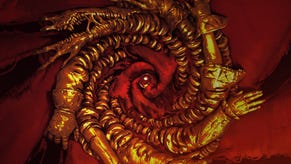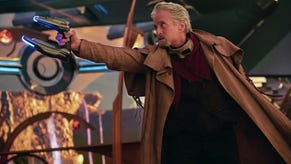E3: Molyneux on Fable: The Journey: “It's not on rails”
Peter's latest looks a lot better in the flesh than it did in Microsoft's presentation. Molyneux explains why he thinks it is “Kinect's finest game.”
It is not on rails
Here's the thing: Fable: The Journey is not on rails. Whilst presenting the game at Microsoft's booth the day after its unveiling at Microsoft's press conference, Molyneux said the words “not on rails” no less than sixteen times. The press conference demo doesn't do it justice, he says – and that's something he feels genuine frustration about.
“We begged for eight minutes, we only got 4, and it was really hard to get across what Fable: The Journey actually was,” says Molyneux. “We only had time to show a little bit of navigation and little bit of magic. A lot of people have written since that it's Fable on rails – it's NOT on rails. That is a definitive statement. Part of making a Fable experience is to give you a sense of freedom. We absolutely want that. You're free to travel through Albion, taking 300-mile journeys, there are paths and hamlets and caves to explores – it's not on rails.”
To show us that it's not on rails, our demonstrator guides the horse off the path and onto an open field for a little while before pulling the reins and guiding it back. It's a game about exploring that rich and beautiful world of Albion, not a sequence of combat sequences with basic horse interludes. For most of the game, says Molyneux, you'll be either on the reins or in your wagon – the action comes to you.
The Keza MacDonald Horse Metric
Controlling the horse with reins was the most natural method of navigation that Lionhead could come up with, Peter says. “When Microsoft came to us and said go do a core game using Kinect, the first thing we did was ask ourselves, what is important to a core game? And one of the big problems is navigation. We did lots of experimentation with pointing and pushing gestures and jogging on the spot – all utter s**t. And so we had this breakthrough where we set you on a horse and cart. That makes sense if you're sitting down.”
I have a personal method of assessing games which I like to call the Keza MacDonald Horse Metric. Basically, the theory is that if a game has horses, it's substantially more likely to be extremely good. Ocarina of Time: horse. Shadow of the Colossus: horse. Assassin's Creed 2: horse. Red Dead Redemption: TONNES of horses. “We've got some great horse sweat technology, that should be reported on,” says Molyneux. Based on those criteria, then, Fable: The Journey is on the right track.
“We've got some great horse sweat technology that should be reported on."
He's vague about what you actually will get up to when you're not riding the horse, though, stating that the on-rails magic displayed at the Microsoft presentation was not representative of the larger game. “There are not many points, if any in the game, where we'll actually have this kind of action,” he says. “This was just crafted for E3.” He mentions a scenario where you're being guided through the mountains by a sherpa, pointing to choose a path to the summit, but he insists that off-horse gameplay will be relatively rare.
Instead, most of the time, the action comes to you. Peter describes an interlude where you're going through the woods when wolves start chasing and attacking you in your carriage, leaping at your horse and tearing at its flanks. Your horse spooks and run off, forcing you to wrestle it back under control, before a wheel comes off the carriage, knocking your passengers to the ground. The woods around you are full of wolves – so you've got to fend them off, heal your horse, protect your passengers and repair your wagon, all at once.
Creation and really good Kinect games
That intriguing magic system also isn't restricted to special set-piece sections – you can use it anywhere, in combat, on the wagon or on foot. “This is like a toy. It's a magical toy. Like magic plasticine in your hands,” says Molyneux. You activate crafting – drawing objects in the air with your hands – by essentially doing the mashed potato, and it's not just spears that you can magically create from nothing.
“This creational side is really important,” asserts Molyneux. “You can create a telescope on a mountaintop. You can create a fishing rod and go fishing. Or a spear, a hammer. There are loads of things open to experiment with and you can use it at any time.”
"Whether you like it or not as gamers, controllers, good as they are, are under attack."
Asked why so many vocal Internet commentators are responding to Microsoft's third-generation Kinect titles with such open hostility, Molyneux is insightful. “I think it comes from the gamers inside of us saying 'I love my controller, it's my security blanket, I don't want to give it up',” he says.
“I understand that – until you play a really good Kinect game. I'd say the greatest Kinect game is Fable: The Journey. The reason I say that is because we've had two years of great experience with Kinect. If you really want to make games that will emotionally engage you, is finger and thumb really the way to do that?
“Whether you like it or not as gamers, controllers, good as they are, are under attack. There's a lot of assault on the controller space. There's everything to do with touch on screens and motion controllers, and us designers in the industry, we are excited about this new stuff. I know that controller-based gamers want more games like that, I love them as well, but there is a wonderful opportunity to here give something fresh and different.”
When I asked Molyneux what his favourite launch title was, I was honestly expecting him to say Kinectimals, but that's not the answer I get. “The best one for me and the best inspiration for The Journey was probably Dance Central,” he says, unexpectedly. “That's the one I felt coolest in. Even I felt cool dancing. It's about how you make people feel, that's more important than anything else. That was inspirational.
“I loved the sports title and the party title as well, but like everyone else I want a game that will make the hairs on the back of my neck stand up. That's what the potential is here. I predict this time next year at E3, people will be saying completely different things about Kinect. It wasn't that long ago we all thought that mobile games were rubbish.
“I kick myself when I think about showing this demo. What we should have shown is beautiful moments like when you're healing the horse with your hands. You've not only for fireballs in your hands, you've got life force. It makes your heart sing.”
Fable: The Journey is slated for release in 2012.











